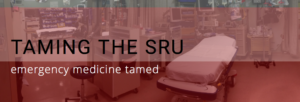Nursing FOAMed Review #11 (May 3rd – May 25th)
Justin Morganstern and First 10 EM show us why Tramadol isn’t a great idea. Ever. I know that there are a lot of providers and nurses out there who love Tramadol. I’m just not one of them. Why? CYP2D6 – that’s why. Don’t know what CYP2D6 is? That’s okay – actually, I’ll amend that – it is probably good. Not knowing about CYP2D6 is probably the sign of a healthy social life. But in case you want to learn about why Tramadol (and also Codeine) are less than optimal options for analgesia, go ahead and click on the hyperlinks. This is fascinating stuff, and Dr. Morganstern does a wonderful job explaining why some folks get 40mg of Tramadol and scream for more pain medication, and other folks get 40mg of Tramadol and then slip into a euphoric slumber. Long story short: these two drugs are opioid pro-drugs – both converted to morphine in the liver by the CYP2D6 enzyme. The only potential problem there, is that some people have faulty CYP2D6 enzymes that poorly convert Tramadol and Codeine to morphine, while others are “super metabolizers” who convert these pro drugs to morphine at up to 17x the rate of a faulty metabolizer. There is a lot of data out there on this – and yet somehow we continue to see these drugs used. Don’t believe me? Just Google “Tramadont”.
emdocs has a handy write up on what to do in the case of an ICD malfunction. There is a lot of great information in this piece, so do a thorough read for all take-home pearls:
- When to grab the magnet and when to leave it where it is.
- Antiarrhythmic choices based on presenting rhythms.
- A few reasons to perhaps ignore that elevated Trop and new onset ST elevation after ICD malfunction.
- A handy “rhythm device identification based on CXR” spreadsheet
Josh Farkas writes for EMCRIT about a study evaluating the safety of immune checkpoint inhibitors for the treatment of septic shock. Now I don’t know about you – but I have heard diddly-squat about checkpoint inhibitors being used for sepsis – and that’s totally okay because that’s not why I’m linking the article – and that’s not why Josh Farkas wrote the article. This article is about the perils of published medical studies – and what kind of garbage can slip under the radar when we don’t read critically. The reason I’m highlighting this article by Josh Farkas is that it dives into the shenanigans that we have to be vigilant about when trying to educate ourselves about medicine. Read this critique – and apply the lessons therein.
The Internet Book of Critical Care (IBCC via EMCRIT) strikes again with a chapter on rhabdomyolysis. Emergency department handling of rhabdo (at least from a nurses perspective) tends to be pretty simple in practice – physical examination and CK lab results = positive or negative rhabdo. But Josh Farkas’ thorough explanation of the pathophysiology, diagnosis and treatment of this disease can really help elevate your nursing skills to another level. Some pearls from the chapter:
- CK isn’t the entire diagnosic story! Look for elevated myoglobin, K, Phos and low calcium
- If treatment is started make sure to track strict I&O – this is the defining factor in continuation or ceasing of fluid resuscitation. (Duh… but how often do we actually track strict I&O in the ED?)
- If you don’t know who Gearoid McMahon is (I sure as hell didn’t) you 100% need to read this chapter.
Ryan Radecki writes for Emergency Medicine Literature of Note and brings us an interesting take on a recent trail published here in the Journal of American College of Cardiology concerning ECPR treatment protocols for cardiogenic shock post AMI. I love the science behind ECMO – and some of the case studies and survival stories are simply amazing. But is ECMO the panacea that advocates sometimes act like it is? Probably not – and I personally take issue with hospitals spending tens of millions on ECMO programs when most of us can’t even hand a newly diagnosed diabetic pt a working take home glucometer. Take a read and let me know what you think.
Bad patient handoffs – one of my pet peeves at shift change. When I get a patient handoff I usually care about 4 things – symptoms, differential or diagnosis, lab values and meds received and ordered. That’s about it. But I typically get none of this information. Usually I end up with a synopsis of the patients personal life, their general attitude towards staff, and whether or not the patient is going to be an “easy one” or not. This is what I call a “doofus report” – as in “thanks for the report doofus” – We’ve talked about the patient, but I still know nothing important concerning the patient’s care. The CanadiEM article reviews handy acronyms like SBAR and IPASS. Read this article from CanadiEM and avoid being a doofus at hand off.
Taming the SRU has a wonderful article and podcast on LVADs and LVAD management in the ED. I work at a “certified LVAD center” – which is scary as hell because the amount of practical experience I have with LVAD emergencies is about as limited as most ED nurses – meaning next to nothing. Unless I suddenly show up to work and get LVADs “all day every day” for the next few weeks, these FOAMed resources are probably about the best training I can get. Take a listen and identify you knowledge gaps! As usual, there are some great pearls in the podcast, including:
- LVADs with over-sewn aortic valve – don’t know what that is or how that affects care?? You need to listen!
- LVAD flow measurements are not necessarily accurate measures of tissue perfusion.
- Diagnosing suction events (hello POCUS), giving fluids and adjustments of pump speeds.
- Continuous flow and resulting GI bleeds (20% to 40% of LVAD pts will develop a GI bleed!)






